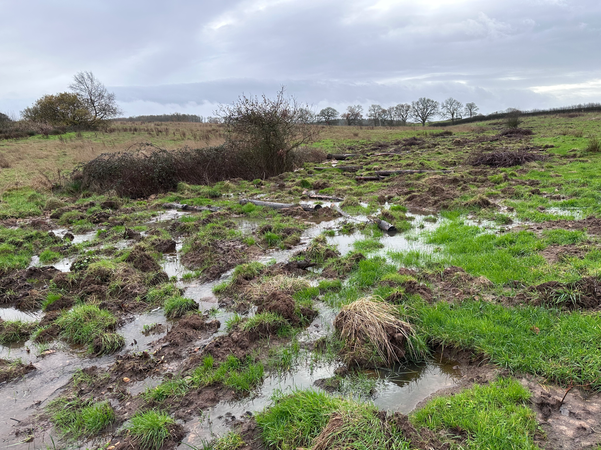
Wetland Restoration Project
Background
Beneath the topsoil at Heal Somerset lies a clay-rich substrate, made up of tightly compacted particles that hold onto water. This makes the ground naturally heavy, slow to drain and prone to waterlogging in some places.
For centuries, people have tried to adapt this type of land for farming. Since Roman times, ditches and drains have been installed to take water away. In the Victorian era, large-scale field drainage systems were introduced, using clay pipes buried below the surface to speed up the process. Today, the Heal Somerset landscape is crossed with a hidden network of old drains (made of terracotta, plastic and concrete), carrying rainwater quickly into man-made ditches and streams.
As a result, rainfall leaves the land much faster than it would under natural conditions, affecting the three tributaries of the River Frome that flow through the site. Restoring a more natural movement of water across the land is therefore a vital part of our rewilding work at Heal Somerset.

What's happened so far
Funding from the Environment Agency (EA) and the Somerset Rivers Authority (SRA) through the Farming & Wildlife Advisory Group (FWAG) was confirmed in early autumn 2025, which meant we could move forward with the next major rewilding step - renaturalising the watercourses.
This has involved:
-
Blocking old ditches and re-routing water flow. Several artificial ditches have been blocked, allowing water to move through more natural flow paths.
-
Landscaping a small wetland area. We’ve created a small wetland by digging a wiggly channel with pools and scalloped edges that lead into a series of bunds (embankments). These features will hold water on the land for longer, creating a range of wet and damp habitats for wildlife.
-
Breaking up old land drains. To reduce drainage and restore natural hydrology, we’ve broken up some land drains. Over the larger ones, we’ve built bunds that now form permanent (or possibly temporary – time will tell!) pools of standing water.
-
Stage zero restoration in a valley bottom. In one area, we’ve completely filled in a ditch that used to run along the base of a shallow valley. This creates what’s known as a “stage zero” restoration, where water spreads and seeps naturally across the valley floor, just as it would in an undisturbed system.
-
Creating leaky dams behind the farm buildings. In a stretch of ditch near the farm, we’ve built a series of leaky dams. These slow down the flow of water and create a chain of small pools, some with scalloped edges for extra capacity and a softer, more natural appearance.
-
Hinging trees. In our northern tributary, we’ve hinged several trees and hazel stands into the watercourse. These help slow the flow during high-water (spate) events and let more light reach the water, encouraging a richer mix of aquatic and marginal plants.
What does this look like for visitors?
Initially the works will look quite stark, with lots of disturbance leaving bare clay earth on show. The topography of the land has changed in places and parts of the ground have been torn up.
Later on, this bare earth will become colonised by grasses and plants as a wetland ecosystem emerges. The areas of disturbance will smooth over and look more natural.
What's next?
Now we wait and see! Over time, the land will transform and create exciting new wetland habitat, so we will wait with baited breath to see what changes occur.
There is still opportunity to create small-scale leaky dams in ditches we haven't yet touched, and there are plenty of land drains yet to break up. We are also still awaiting funding to dig our great crested newt ponds.
Over winter 2025 we hope to plant lots of willow whips to kickstart structural vegetation regeneration in the wetter parts.

Benefits
Restores natural hydrology - slowing, spreading and storing water across the landscape. This also:
-
Reduces flood risk downstream - by holding water on site and slowing its flow after heavy rain
-
Increases resilience to drought - more water is retained in soils and pools which helps the landscape to stay green and thriving through dry periods
Boosts biodiversity - creating a rich mosaic of wet and dry habitats for plants, insects, amphibians, birds and mammals
Encourages natural vegetation recovery - wetter conditions help native wetland species re-establish and outcompete invasive plants
Creates breeding and feeding areas - new pools and channels support frogs, toads, dragonflies and other aquatic life
Stores carbon naturally - re-wetted soils and growing vegetation lock up carbon and help tackle climate change
Reduces runoff and soil degradation
Enhances the landscape visually - creates a more varied, natural and wild environment

Key facts
-
What? See 'What's happened so far' above!
-
When? October 2025
-
Where? Heal Somerset
-
Why? See 'Benefits' above!
-
How long did the work take? Two weeks
-
Who did the works? Four people and four diggers from Quantock and Exmoor Ltd
-
Where did the funding come from? The Environment Agency (EA) and the Somerset Rivers Authority, through the Farming & Wildlife Advisory Group (FWAG)









